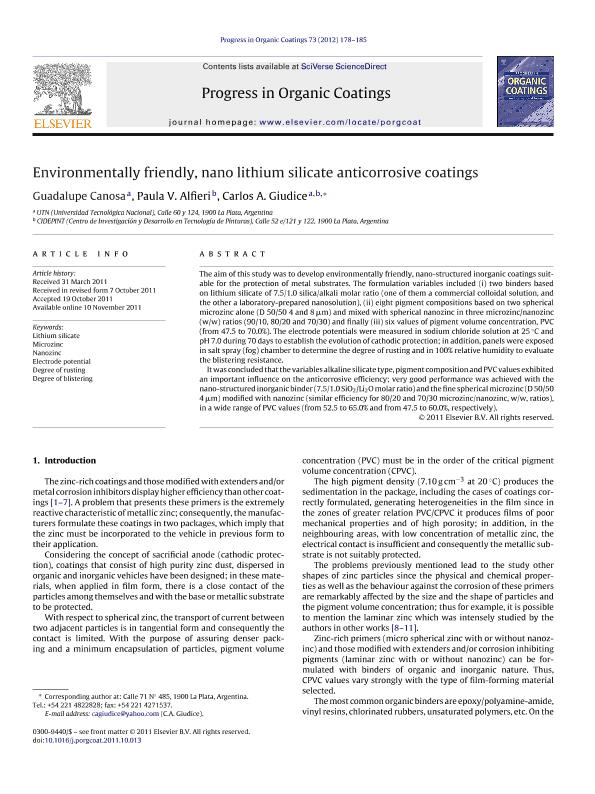Mostrar el registro sencillo del ítem
dc.contributor.author
Canosa, Guadalupe

dc.contributor.author
Alfieri, Paula Vanesa

dc.contributor.author
Giudice, Carlos Alberto

dc.date.available
2020-01-07T20:49:49Z
dc.date.issued
2012-02
dc.identifier.citation
Canosa, Guadalupe; Alfieri, Paula Vanesa; Giudice, Carlos Alberto; Environmentally friendly, nano lithium silicate anticorrosive coatings; Elsevier Science Sa; Progress in Organic Coatings; 73; 2-3; 2-2012; 178-185
dc.identifier.issn
0300-9440
dc.identifier.uri
http://hdl.handle.net/11336/93914
dc.description.abstract
The aim of this study was to develop environmentally friendly, nano-structured inorganic coatings suitable for the protection of metal substrates. The formulation variables included (i) two binders based on lithium silicate of 7.5/1.0 silica/alkali molar ratio (one of them a commercial colloidal solution, and the other a laboratory-prepared nanosolution), (ii) eight pigment compositions based on two spherical microzinc alone (D 50/50 4 and 8 μm) and mixed with spherical nanozinc in three microzinc/nanozinc (w/w) ratios (90/10, 80/20 and 70/30) and finally (iii) six values of pigment volume concentration, PVC (from 47.5 to 70.0%). The electrode potentials were measured in sodium chloride solution at 25 °C and pH 7.0 during 70 days to establish the evolution of cathodic protection; in addition, panels were exposed in salt spray (fog) chamber to determine the degree of rusting and in 100% relative humidity to evaluate the blistering resistance. It was concluded that the variables alkaline silicate type, pigment composition and PVC values exhibited an important influence on the anticorrosive efficiency; very good performance was achieved with the nano-structured inorganic binder (7.5/1.0 SiO 2/Li 2O molar ratio) and the fine spherical microzinc (D 50/50 4 μm) modified with nanozinc (similar efficiency for 80/20 and 70/30 microzinc/nanozinc, w/w, ratios), in a wide range of PVC values (from 52.5 to 65.0% and from 47.5 to 60.0%, respectively).
dc.format
application/pdf
dc.language.iso
eng
dc.publisher
Elsevier Science Sa

dc.rights
info:eu-repo/semantics/openAccess
dc.rights.uri
https://creativecommons.org/licenses/by-nc-sa/2.5/ar/
dc.subject
DEGREE OF BLISTERING
dc.subject
DEGREE OF RUSTING
dc.subject
ELECTRODE POTENTIAL
dc.subject
LITHIUM SILICATE
dc.subject
MICROZINC
dc.subject
NANOZINC
dc.subject.classification
Ingeniería de los Materiales

dc.subject.classification
Ingeniería de los Materiales

dc.subject.classification
INGENIERÍAS Y TECNOLOGÍAS

dc.title
Environmentally friendly, nano lithium silicate anticorrosive coatings
dc.type
info:eu-repo/semantics/article
dc.type
info:ar-repo/semantics/artículo
dc.type
info:eu-repo/semantics/publishedVersion
dc.date.updated
2019-05-06T14:42:16Z
dc.journal.volume
73
dc.journal.number
2-3
dc.journal.pagination
178-185
dc.journal.pais
Países Bajos

dc.journal.ciudad
Amsterdam
dc.description.fil
Fil: Canosa, Guadalupe. Universidad Tecnologica Nacional. Facultad Regional La Plata; Argentina
dc.description.fil
Fil: Alfieri, Paula Vanesa. Provincia de Buenos Aires. Gobernación. Comisión de Investigaciones Científicas. Centro de Investigaciones en Tecnología de Pinturas. Consejo Nacional de Investigaciones Científicas y Técnicas. Centro Científico Tecnológico Conicet - La Plata. Centro de Investigaciones en Tecnología de Pinturas; Argentina
dc.description.fil
Fil: Giudice, Carlos Alberto. Universidad Tecnologica Nacional. Facultad Regional La Plata; Argentina
dc.journal.title
Progress in Organic Coatings

dc.relation.alternativeid
info:eu-repo/semantics/altIdentifier/url/http://www.sciencedirect.com/science/article/pii/S0300944011003146
dc.relation.alternativeid
info:eu-repo/semantics/altIdentifier/doi/http://dx.doi.org/10.1016/j.porgcoat.2011.10.013
Archivos asociados
